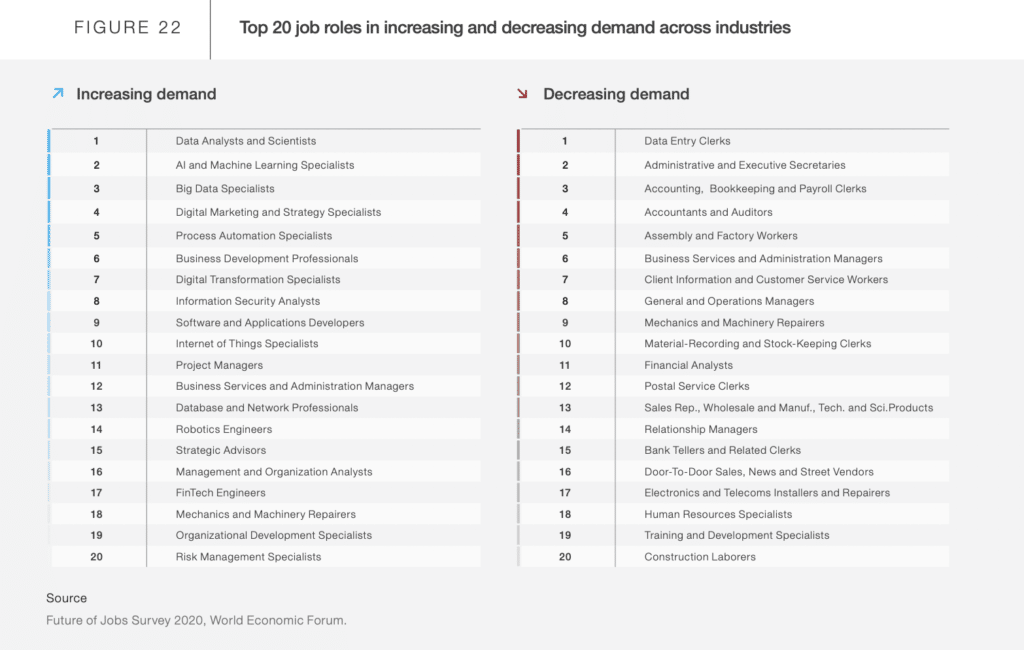Continuous evolution in products and processes is the hallmark of today’s workplace. Add to that a remote workforce and ever-changing needs from employees, clients, customers, and business partners, and phew! No wonder the staff’s competencies don’t match stakeholder expectations rather often.
A skills gap analysis assesses existing talent in your organization and maps it to demands you can anticipate for your staff to remain performant and aligned with business goals. Stick with us for a few minutes while we walk you through the steps to reduce the distance between current and future skills needed by your company. And find out the skills gap analysis template we strongly recommend you use to identify the lacking skills in your workforce you must recruit for or train in.
What Is a Skills-Gap Analysis?
Skills gap analysis is a periodic pulse check of the skills an organization needs to function as a profitable entity. In other words, it’s a comparison between your personnel’s current skills and the skills they’re missing to raise your company’s bottom line.
In a highly competitive global business environment, it’s essential to identify skills gaps. That’s the initial step in ensuring that organizations can compete effectively. After all, when you don’t have the right skills within your workforce, your ability to fulfill your business’s core mission is compromised. And when you’re unaware that skills are missing, you’re even further from achieving competitiveness.
If you compare the market in which your company operates to how your business operates on the inside, there’s a demand-supply equation determining the success of both. And that’s true whether you’re in the service industry, producing raw materials, or running a manufacturing plant. The product you offer to the market must fulfill the needs of clients or customers, and your employees’ skills must fulfill the needs of your company (to be able to offer that product).
Why Conduct a Skills-Gap Analysis?
Business leaders and people managers must continually measure their inventory of workplace skills. Why? Because by measuring the skills of your staff—or performing a skills analysis—you gather actionable data to assist you in
- Managing the company’s skill portfolio
- Planning for leadership development
- Improving the business’s competitiveness down the line
You see, if your organization wants to thrive and prosper in the current business landscape of high evolution and global scale, your managers and their teams must develop the skills to achieve the desired business goals.
And that’s when you start asking questions.
- Which skill sets do they currently have, and which ones must they develop?
- How much of each skill set do they need now, and how much will they need over time?
- Can you train existing personnel or onboard new hires in time to fill in critical skills gaps?
- How much time, people, and money do you need to deliver that training?
The answer to all the above lies in performing a skills gap analysis.
A great example of skills analysis would be to assess skills gaps in a company to understand whether existing in-house skill sets allow the business to move from the bricks-and-mortar model to an online store.
Skills such as Web design, digital marketing, or eCommerce management might not exist in-house at the moment or may not be high enough in the organization’s current workforce plan. Yet, those are precisely the skills required to transform the company’s business model. And without skill assessments, they’d never know which skills are missing.
Related: Leadership Development Plan
How Does a Skills Gap Analysis Help Your Organization
Many of the skills that organizations rely on right now might not be as relevant in the future. And newer skills, some of which are still evolving, will play a significant part in future competitiveness.
Besides, according to a survey by the World Economic Forum on The Future of Jobs, “by 2025, increasingly redundant roles will decline from being 15.4% of the workforce to 9% (6.4% decline), and (…) emerging professions will grow from 7.8% to 13.5% (5.7% growth).” This means that certain jobs will see higher demand in the future, whereas others will likely see a decline instead.

If your business is to embrace the future, consider using these findings to tailor a skills gap analysis template and conduct a skills gap analysis to determine the skills shortage you must prepare for. And remember to make skill assessments comprehensive and ongoing.
Now, when you assess skills gaps, you’re doing more than just highlighting the skills your company lacks, whether that’s a partial or full lack. The analysis has other effects on the workforce and the business.
Motivates Learning & Development
Analyzing existing skills within your organization and mapping the deficit to future needs helps prepare employees to fulfill those needs. But mapping alone isn’t enough.
When you identify skills gaps, you’re initiating a training gap analysis, and that’s when training vs. learning comes into play.
Continuous workplace learning is essential to keep tabs on the skills that future roles will require. And delivering training is how you start filling in the identified gaps.
Also, when you present personnel with data—in this case, skill assessments—that support their career paths, you’ll probably motivate them more to undergo the recommended training. The result? They’ll develop the skills needed for future roles.
Improves Recruitment
When anticipating a staffing shortage, many HR departments rush to hire immediately. But they must be strategic rather than reactive; otherwise, they risk spending a lot of money hiring people with skills that may become redundant in a few years.
Recruitment must be an exercise of balance in which you consider multiple variables: urgency, budget, onboarding time vs. upskilling time, and future needs. And if you only weigh immediate skill needs, you’ll miss out on all the other (important) variables.
Hiring initiatives focused on future skill needs originate better staffing decisions. Our recommendation is that you create an instance of your skills gap analysis template per role, highlight the skills each role will demand in the future, and go from there.
Related: Employee Onboarding Training
Identifies Team Needs
Skills analysis enables team success. Its primary goal is to determine the skill sets your team needs to achieve the desired outcomes and those they haven’t yet developed. And unless you perform skill assessments and a training gap analysis, you can’t possibly identify skills gaps and fill in those gaps with the necessary training.
Assists with Strategic Workforce Planning
Skills gap analysis is an essential part of planning workforce supply and demand. And because it consists of analyzing the current state of talent development in your company and forecasting its future state, it’s a strategic process.
That’s excellent because the World Economic Forum study we mentioned earlier, on the future of jobs, stressed that successful businesses hire and train workforces strategically. In other words, the Forum advised against short-term, tactical staffing only—to fill in existing skills gaps—and in favor of more strategic, long-term staffing—to fill in future skills gaps, too.
Related: Talent Development Strategies to Unleash Employee Potential
Supports Competitive Advantage
One of your company’s big assets, if not the biggest, is your personnel. It is people, more than technology, equipment, or processes, who pave the way for your business to be competitive and, ultimately, profitable.
But to make sure you have the right people with the right skills on board, you must continuously train and develop them. You must assess skills gaps and plan your workforce strategy accordingly.
Helps Know Your Team Better
Although “gap analysis” means determining something that’s missing, skill assessments (with a well-prepared skills gap analysis template) sometimes reveal skill sets that exist within teams without managers or HR knowing it.
But what’s most intriguing about untapped skills is that they’re potentially invaluable to the company yet went unnoticed until the skills analysis. Only then do organizations discover them and get to put them to good use instead of hiring more staff, starting with a training needs analysis.
As a result, training managers define how to evolve existing skills in the direction of anticipated needs through learning and development programs. In other words, skills gap analysis supports the elaboration of training plans.
Skills Gap Analysis Template
Generally speaking, Word or Excel templates save a lot of time and effort. And a skills gap analysis template is no different when it comes to performing skill assessments.
But no two roles or teams, even if they belong to competitor companies, require the exact same skill sets. You’ll likely need to tailor the template that’s closer to your context to obtain the document you’re looking for.
Just choose one that can accommodate your changes without much sweat. Remember that a skills gap analysis template determines not only the course of the assessment but also the workforce strategy, hiring initiatives, and training plans that follow it.
Luckily, our template for skills analysis is customizable. Just have a look at it and download or make a copy of it on Google Sheets by clicking the link below.
Prerequisites of a Good Skills Gap Analysis Template
When selecting a template to conduct a skills gap analysis, make sure it is
- User-friendly. Excessively complex or poorly-structured templates are hard to navigate and often lead to unsatisfactory results.
- Concise. Extremely lengthy templates take a long time to fill out and longer to analyze.
- Well-documented. An annotated template is self-contained, providing instructions and examples for each question.
- Customizable. It’s never too much to remind you that because your company is unique, you must choose a template you can adjust to your requirements.
Elements of a Good Skills Gap Analysis Template
Regardless of the format and layout of the template you select, the Regardless of its file format and layout, the template you select must, at minimum, contain the following elements:
- Current and future snapshots. The template must allow you to register the skills that a role or team has and the ones it must have in the future.
- Depth of gaps. The template must allow you to calculate how deep the gaps between current and future skills are.
- Factors that caused the gaps. The template must include space for you to elaborate on the reasons why the gaps exist.
Gap remediation. The template must contain a section where you can enumerate solutions to close the identified gaps.
How to Perform a Skills Gap Analysis
Skills analysis is a sequence of steps in which the data collected during the previous step feeds into the following step. And an Excel-based skills gap analysis template like ours comes in quite handy, as it automatically establishes connections between steps. But there’s more to skills gap analysis than filling out such a template.
Below, you’ll find the steps of skill assessments you must follow to customize the skills gap analysis template, fill it out, and act on the results you’ll obtain.
Define Your Plan
This step involves outlining your methodology to assess skills gaps. Choose a team, set realistic timelines, and allocate resources to the process (budget, personnel, time, technology, and physical space if they work in the office).
Also, determine the scope of the analysis. Do you need to identify skills gaps for roles across the entire company or a specific unit only? Or do you need to analyze the roles of a single department, such as marketing or engineering roles? Perhaps you only need to conduct a skills gaps analysis for a particular team. All of these options are valid, so it’s up to you to decide according to your organization’s needs.
Get Clear on Goals
There’s a correlation between business goals and skills gaps because business goals define the skills needed to accomplish those goals. Make sure you elicit the goals before customizing the skills gap analysis template.
Identify Future Skills
Go through your business goals and determine the skills required to reach those goals. Register the skills in the template and score them for importance.
Pinpoint Current Skills
Take inventory of existing skills. Now, two people can have the same skill, but they may not have any skill in common, so you must assess the current skills of each person.
Do it against the future skills you listed in the previous step and comment on the reasons why each gap exists.
Determine the Gaps (Perform the Analysis)
This is when you try to match existing to future skills and calculate the gap between them.
Our skills gap analysis template automatically does the math for you. It calculates the gap per skill, whether you assess skills for the entire company, a unit, a department, or a team. You just need to indicate the target level of skill development for each skill.
Create a Strategy and Act on the Results
Finally, it’s time to define an action plan and put processes in place to close the skills gaps.
If your skills gap analysis template allows taking notes on why the gaps exist and possible solutions to close them, that’s perfect—ours does. If not, the solutions might be hiring staff that already possess the lacking skills or training existing staff on those skills.
Identify Skills Gaps Now for Maximum Profitability
A skills gap analysis template is a resource that helps team leaders, HR managers, and training coordinators perform skills analysis. It assists those professionals in following a series of steps that lead to a clearer picture of the organization’s skill deficiencies and what to do to eliminate them.
Whereas skill assessments identify the shortage of skills required for your company to become or remain competitive against others in the market, they may also reveal skills your people already have without you knowing it.
Most importantly, if you haven’t performed a skills gap analysis at your organization yet, now’s the time! Your business might be missing out on opportunities to thrive and prosper as we speak. With the help of a skills gap analysis template and detailed training gap analysis, you can efficiently identify hiring or upskilling needs, whether they’re more or less urgent.





